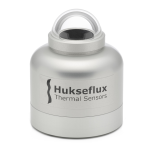This product is not available for new orders. We recommend ordering: SR05-L.

| Services Available | |
|---|---|
| Repair | Yes |
| Calibration | Yes |
| Free Support | Yes |
概览
LP02 是ISO 二级太阳辐射传感器,监测全太阳波段范围内的太阳辐射。可直接连接到Campbell Scientific数据采集器,广泛应用于气象学领域。
优势与特点
- Compatible with most Campbell Scientific data loggers
- Measures reflected solar radiation when inverted
- Provides measurements in direct sunlight, under plant canopies, when the sky is cloudy, and in artificial light
- Includes bubble level and leveling screws, eliminating the need for a separate leveling base and simplifying installation
- Acceptable for providing the solar radiation data used in stability estimations
- Dome protects thermopile and allows water to roll off of it
- Designed for continuous indoor and outdoor use
图像



技术说明
LP02 使用由穹顶罩保持的高质量黑化热电堆来测量太阳辐射。黑化热电堆为全太阳辐射波段提供了平直的波段响应,这使得LP02可用于冠层下或灯光光源下,也适用于天空多云的条件,以及用于反射辐射测量。
LP02 包括1个水平泡、3个可调节螺丝和1个线缆压盖。水平泡和可调节螺丝可让传感器调节到水平状态,而不需要单独的水平底座。线缆压盖方便线缆的更换。
LP02 产生毫伏信号输出,由坎贝尔数据采集器直接测量。
两个LP02 短波辐射表可以背靠背固定在一起,组成一个低成本的返照率表;请联系坎贝尔以寻求更多信息。
产品规格
| Sensor | Blackened thermopile protected by a dome |
| Measurement Description | Monitors solar radiation for the full solar spectrum range |
| Spectral Range | 285 to 3000 nm |
| Maximum Irradiance | 2000 W/m2 |
| Sensitivity | 15 µV/W/m2 (nominal) |
| Operating Temperature Range | -40° to +80°C |
| Temperature Dependence | < 0.15% per °C |
| ISO Classification | ISO 9060:2018 spectrally flat Class C (second class) |
| Body Diameter | 7.8 cm (3.1 in.) |
| Dome Diameter | 3.0 cm (1.2 in.) |
| Height | 5.9 cm (2.3 in.) |
| Weight | 363 g (0.8 lb) with 4.6 m (15 ft) cable |
兼容性
Please note: The following shows notable compatibility information. It is not a comprehensive list of all compatible products.
数据采集器
| Product | Compatible | Note |
|---|---|---|
| 21X (retired) | ||
| CR10 (retired) | ||
| CR10X (retired) | ||
| CR200X (retired) | ||
| CR206X (retired) | ||
| CR211X (retired) | ||
| CR216X (retired) | ||
| CR23X (retired) | ||
| CR295X (retired) | ||
| CR300 (retired) | ||
| CR3000 (retired) | ||
| CR310 | ||
| CR500 (retired) | ||
| CR5000 (retired) | ||
| CR510 (retired) | ||
| CR6 | ||
| CR800 (retired) | ||
| CR850 (retired) | ||
| CR9000 (retired) |
Additional Compatibility Information
Mounting
The LP02 includes a bubble level and three adjusting leveling screws, which allow the sensor to be leveled without using a leveling base. The CM225 Solar Sensor Mounting Stand is used to attach the sensor to a crossarm. The CM225 consists of a rectangular plate, mounting bracket, U-bolts, washers, lock washers, and nuts. The LP02 should be mounted away from all obstructions and reflective surfaces that might adversely affect the measurement.
If the sensor needs to be mounted at an angle, a CM255 or CM255LS adjustable-angle mount can be used instead.
相关技术文档
常见问题解答
LP02-L: 8
展开全部收起全部
-
Perhaps, but it is more likely that there is a wiring or programming issue. If the pyranometer is reading 0 W/m2, separate it from the data logger and measure the resistance across the sensor leads. If the reading is approximately 0 ohms, the sensor has likely been damaged and will need to be repaired or replaced. For information about the process of returning equipment to Campbell Scientific, refer to the Repair and Calibration page.
-
Yes. Depending on the application, it is recommended to have the sensor calibrated every one to two years.
-
Yes. It is recommended to clean the dome weekly. However, depending on the environment the pyranometer is deployed in, it may need to be cleaned more frequently—perhaps daily. The frequency of the cleaning schedule varies based on the amount of buildup on the dome caused by precipitation, dust, and biological films.
-
The LP02-L measures solar irradiance with primary units of W/m2 and over a range of 0 to ≈1000 W/m2 for terrestrial radiation. Other units can be measured with modifications to the measurement instruction in the data logger’s program.
-
The LP02-L produces an analog millivolt signal that is linearly related to the amount of solar radiation incident on the device. This relationship is based on a calibration coefficient that is entered in the data logger program.
-
For best results, use a differential voltage instruction, such as VoltDiff(). A single-ended voltage instruction, VoltSe(), could be used; however, this would not take full advantage of input reversal, which allows for the subtraction in common-mode gain errors. For more information, see the “The Benefits of Input Reversal and Excitation Reversal for Voltage Measurements” white paper.
-
The LP02-L is a sensor manufactured by Hukseflux, whereas the CMP3-L is manufactured by Kipp & Zonen. Both sensors meet the ISO classification of a Second Class pyranometer.
-
Because of the loss of IR radiation, nearly all thermopile instruments typically have a negative offset. This offset is most easily visible at night-time, when a small negative value is read instead of zero. This same offset is present during the daytime, but it is not as visible because of the large solar signal.
Another common issue involves leveling an instrument. Leveling a thermopile instrument can cause errors in the direct beam component because the cosine response is not correct. These errors are more notable when the sun is close to the horizon because the angle is so shallow.


